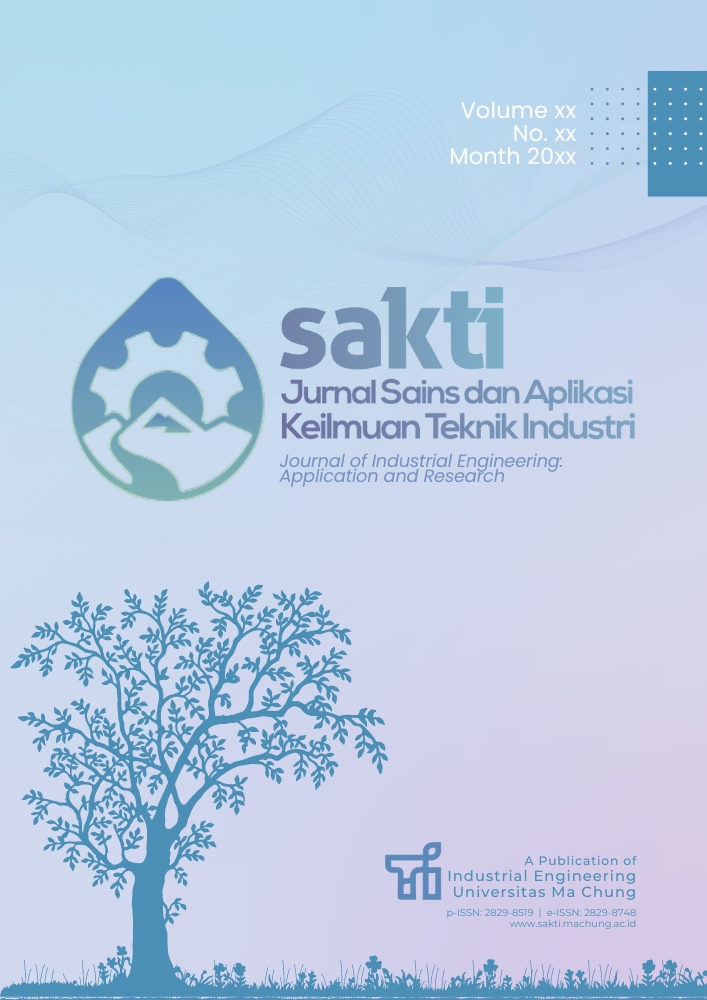Analisis Efektivitas Mesin Cetak Flexo menggunakan Metode Overall Equipment Effectiveness Berbasis Six Big Losses
Studi Kasus: Industri Corrugated Box
DOI:
https://doi.org/10.33479/sakti.v4i1.71Kata Kunci:
availability ratio, overall equipment effectiveness, performance efficiency, quality ratio, six big lossesAbstrak
PT X is a manufacturing company operating in the integrated cardboard industry, utilizing various machines, including flexography machines. This study aims to analyze the primary causes of production deficiencies in the flexography process and provide improvement recommendations using the Six Big Losses-based Overall Equipment Effectiveness (OEE) method. The OEE analysis revealed that the average availability ratio is 88.8%, falling short of the world-class standard of 90%. A deeper analysis using the Six Big Losses methodology identified that the primary cause for not achieving the desired availability ratio is the high percentage of setup and adjustment losses, which stands at 7%. To address these issues, several recommendations are proposed. Firstly, conducting comprehensive training for operators on the proper and correct operation of flexography machines is essential. This training will enhance their technical skills and reduce the time lost during setup and adjustments. Secondly, implementing daily briefings for operators before shifts begin, coupled with regular supervision, will ensure consistent adherence to operational standards. Moreover, establishing a routine and time-limited cleaning schedule for machines and work locations will minimize unexpected downtimes due to maintenance issues. Finally, developing and enforcing standardized machine operation protocols will promote discipline among operators, ensuring that all procedures are followed meticulously. These recommendations aim to improve the overall efficiency of flexography machines, thereby increasing the availability ratio to meet or exceed the world-class standard. By addressing the root causes of production inefficiencies, PT X can enhance its operational performance and maintain its competitive edge in the cardboard industry.
Referensi
Affan, A. (2021). Analisis Perhitungan Efektivitas pada Mesin Ryoby untuk Meningkatkan Produktivitas dengan Menggunakan Metode Overall Equipment Effectivenes (OEE) dan Six Big Losses di CV. Kyta Jaya Mandiri. IEJST (Industrial Engineering Journal of the University of Sarjanawiyata Tamansiswa, 4(1).
Aurelia, C., Noya, S., & Oktiarso, T. (2023). Analisis Produktivitas PT Torabika Eka Semesta Menggunakan Metode Objective Matrix dan Fault Tree Analysis. Jurnal Sains dan Aplikasi Keilmuan Teknik Industri (SAKTI), 3(1), 33-48. https://doi.org/10.33479/jtiumc.v3i1.44
Blanchard, B. S. (1997). An enhanced approach for implementing total productive maintenance in the manufacturing environment. Journal of quality in Maintenance Engineering, 3(2), 69-80.
Chikwendu, O. C., Chima, A. S., & Edith, M. C. (2020). The optimization of overall equipment effectiveness factors in a pharmaceutical company. Heliyon, 6(4).
Dal, B., Tugwell, P., & Greatbanks, R. (2000). Overall equipment effectiveness as a measure of operational improvement–a practical analysis. International journal of operations & production management, 20(12), 1488-1502.
Jessika, I.P.G., Saragih, J., & Kurniawan, W., 2019, Usulan Perbaikan Kualitas Karton Sheet Tipe BC Flute dengan Metode Six Sigma dan Fuzzy Failure Mode and Effect Analysis (FMEA) di PT. Kati Kartika Murni. Prosiding Seminar Nasional Pakar (pp. 1-47).
Pribadi, M., Putrianto, N.K., & Purnomo, P. (2023). Designing a Macro-VBA Excel-based Kit List Printing Application for the Supporting Department of PT XYZ, Jurnal Sains dan Aplikasi Keilmuan Teknik Industri (SAKTI), 3(1), 59-66. https://doi.org/10.33479/jtiumc.v3i1.46
Sayuti, M. (2019, June). Analysis of the Overall Equipment Effectiveness (OEE) to Minimize Six Big Losses of Pulp Machine: A Case Study in Pulp and Paper Industries. IOP Conference Series: Materials Science and Engineering (Vol. 536, No. 1, p. 012061). IOP Publishing.
Septa, F. & Putrianto, N.K. (2023). Problem Analysis in Sub-Assembly Department Using Empathize Design Thinking and Failure Mode Effects Analysis: A Case Study of PT X, Jurnal Sains dan Aplikasi Keilmuan Teknik Industri (SAKTI), 3(1), 13-22. https://doi.org/10.33479/jtiumc.v3i1.47
Soejanto, J.C., Ekawati, Y., & Purnomo, P. (2023). Perancangan Perbaikan untuk Mengurangi Cacat Produk pada Departemen Fiber PT XYZ dengan Metode FTA, Jurnal Sains dan Aplikasi Keilmuan Teknik Industri (SAKTI), 3(2), 99-108. https://doi.org/10.33479/jtiumc.v3i2.50









